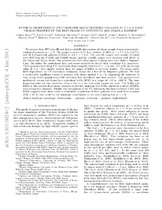| dc.contributor.author | Jiang, Linhua | |
| dc.contributor.author | Egami, Eiichi | |
| dc.contributor.author | Mechtley, Matthew | |
| dc.contributor.author | Fan, Xiaohui | |
| dc.contributor.author | Cohen, Seth H. | |
| dc.contributor.author | Windhorst, Rogier A. | |
| dc.contributor.author | Dave, Romeel | |
| dc.contributor.author | Finlator, Kristian | |
| dc.contributor.author | Kashikawa, Nobunari | |
| dc.contributor.author | Ouchi, Masami | |
| dc.contributor.author | Shimasaku, Kazuhiro | |
| dc.date.accessioned | 2018-01-11T11:46:12Z | |
| dc.date.available | 2018-01-11T11:46:12Z | |
| dc.date.issued | 2013 | |
| dc.identifier.citation | Jiang, L. et al. (2013). Physical properties of spectroscopically confirmed galaxies at Z ≥ 6. I. Basic characteristics of the rest-frame UV continuum and lyman-alpha emission. The Astrophysical Journal , 772: 153 | en_US |
| dc.identifier.issn | 0004-637x | |
| dc.identifier.uri | http://dx.doi.org/10.1088/0004-637X/773/2/153 | |
| dc.identifier.uri | http://hdl.handle.net/10566/3380 | |
| dc.description.abstract | We present deep HST near-IR and Spitzer mid-IR observations of a large sample of spectroscopically-
confirmed galaxies at z ≥ 6. The sample consists of 51 Ly-alpha emitters (LAEs) at z ≃ 5.7, 6.5, and 7.0,
and 16 Lyman-break galaxies (LBGs) at 5.9 ≤ z ≤ 6.5. The near-IR images were mostly obtained
with WFC3 in the F125W and F160W bands, and the mid-IR images were obtained with IRAC in
the 3.6μm and 4.5μm bands. Our galaxies also have deep optical imaging data from Subaru Suprime-
Cam. We utilize the multi-band data and secure redshifts to derive their rest-frame UV properties.
These galaxies have steep UV continuum slopes roughly between ≃ −1.5 and –3.5, with an average
value of ≃ −2.3, slightly steeper than the slopes of LBGs in previous studies. The slope shows
little dependence on UV continuum luminosity except for a few of the brightest galaxies. We find
a statistically significant excess of galaxies with slopes around ≃ −3, suggesting the existence of
very young stellar populations with extremely low metallicity and dust content. Our galaxies have
moderately strong rest-frame Ly equivalent width (EW) in a range of ∼10 to ∼200 °A. The star-
formation rates are also moderate, from a few to a few tens solar masses per year. The LAEs and
LBGs in this sample share many common properties, implying that LAEs represent a subset of LBGs
with strong Ly-alpha emission. Finally, the comparison of the UV luminosity functions between LAEs and
LBGs suggests that there exists a substantial population of faint galaxies with weak Ly-alpha emission
(EW < 20 °A) that could be the dominant contribution to the total ionizing flux at z ≥ 6. | en_US |
| dc.language.iso | en | en_US |
| dc.publisher | American Astronomical Society | en_US |
| dc.rights | This is a pre-print version arXiv.org (arXiv:1303.0027v2) of the article found online at: http://dx.doi.org/10.1088/0004-637X/773/2/153 | |
| dc.subject | Cosmology | en_US |
| dc.subject | Observations | en_US |
| dc.subject | Galaxies | en_US |
| dc.subject | Evolution | en_US |
| dc.subject | High-redshift | en_US |
| dc.title | Physical properties of spectroscopically confirmed galaxies at Z ≥ 6. I. Basic characteristics of the rest-frame UV continuum and lyman-alpha emission | en_US |
| dc.type | Article | en_US |
| dc.privacy.showsubmitter | FALSE | |
| dc.status.ispeerreviewed | TRUE | |
| dc.description.accreditation | Web of Science | |

